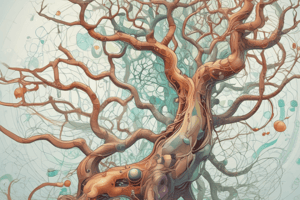Podcast
Questions and Answers
The plasma membrane is responsible for generating energy for the cell through cellular respiration.
The plasma membrane is responsible for generating energy for the cell through cellular respiration.
False (B)
Eukaryotic cells are typically small and simple in structure.
Eukaryotic cells are typically small and simple in structure.
False (B)
Ribosomes are responsible for generating energy for the cell through cellular respiration.
Ribosomes are responsible for generating energy for the cell through cellular respiration.
False (B)
Cells are the smallest unit of life that can reproduce itself and carry out all necessary functions to sustain life.
Cells are the smallest unit of life that can reproduce itself and carry out all necessary functions to sustain life.
The nucleus is responsible for protein synthesis.
The nucleus is responsible for protein synthesis.
The Golgi apparatus is primarily responsible for protein synthesis.
The Golgi apparatus is primarily responsible for protein synthesis.
Lysosomes are involved in the synthesis of proteins.
Lysosomes are involved in the synthesis of proteins.
The cytoskeleton provides structural support, shape, and movement to the cell.
The cytoskeleton provides structural support, shape, and movement to the cell.
Meiosis results in two daughter cells with the same number of chromosomes as the parent cell.
Meiosis results in two daughter cells with the same number of chromosomes as the parent cell.
The cell membrane is involved in the regulation of what enters and leaves the cell.
The cell membrane is involved in the regulation of what enters and leaves the cell.
Flashcards are hidden until you start studying
Study Notes
Cells
Definition and Function
- The basic structural and functional unit of life
- The smallest unit of life that can reproduce itself
- Cells carry out all necessary functions to sustain life, including growth, reproduction, response to stimuli, and metabolism
Cell Structure
- Plasma Membrane: semi-permeable membrane that separates the cell from its environment
- Cytoplasm: jelly-like substance inside the cell where metabolic processes take place
- Nucleus: control center of the cell where DNA is stored
- Mitochondria: organelles responsible for generating energy for the cell through cellular respiration
- Ribosomes: organelles responsible for protein synthesis
Cell Types
- Prokaryotic Cells: lack a true nucleus, typically small and simple in structure (e.g. bacteria)
- Eukaryotic Cells: have a true nucleus, typically larger and more complex in structure (e.g. plants, animals, fungi)
Cell Membrane Functions
- Transportation: movement of molecules in and out of the cell through passive and active transport
- Protection: shields the cell from its environment and maintains cellular integrity
- Regulation: controls what enters and leaves the cell
Cell Division
- Mitosis: process of cell division that results in two daughter cells with the same number of chromosomes as the parent cell
- Meiosis: process of cell division that results in four daughter cells with half the number of chromosomes as the parent cell, occurs in reproductive cells
Cellular Organelles
- Endoplasmic Reticulum (ER): network of membranous tubules and cisternae involved in protein synthesis and transport
- Golgi Apparatus: complex of flattened sacs and tubules involved in protein modification and packaging
- Lysosomes: membrane-bound sacs containing digestive enzymes that break down and recycle cellular waste and foreign substances
- Cytoskeleton: network of filaments that provides structural support, shape, and movement to the cell
Cells
Definition and Function
- Cells are the basic structural and functional units of life, capable of reproducing themselves.
- They carry out essential functions such as growth, reproduction, response to stimuli, and metabolism to sustain life.
Cell Structure
Plasma Membrane
- Semi-permeable membrane that separates the cell from its environment.
Cytoplasm
- Jelly-like substance inside the cell where metabolic processes take place.
Nucleus
- Control center of the cell where DNA is stored.
Mitochondria
- Organelles responsible for generating energy for the cell through cellular respiration.
Ribosomes
- Organelles responsible for protein synthesis.
Cell Types
Prokaryotic Cells
- Lack a true nucleus, typically small and simple in structure (e.g., bacteria).
Eukaryotic Cells
- Have a true nucleus, typically larger and more complex in structure (e.g., plants, animals, fungi).
Cell Membrane Functions
Transportation
- Movement of molecules in and out of the cell through passive and active transport.
Protection
- Shields the cell from its environment and maintains cellular integrity.
Regulation
- Controls what enters and leaves the cell.
Cell Division
Mitosis
- Process of cell division that results in two daughter cells with the same number of chromosomes as the parent cell.
Meiosis
- Process of cell division that results in four daughter cells with half the number of chromosomes as the parent cell, occurs in reproductive cells.
Cellular Organelles
Endoplasmic Reticulum (ER)
- Network of membranous tubules and cisternae involved in protein synthesis and transport.
Golgi Apparatus
- Complex of flattened sacs and tubules involved in protein modification and packaging.
Lysosomes
- Membrane-bound sacs containing digestive enzymes that break down and recycle cellular waste and foreign substances.
Cytoskeleton
- Network of filaments that provides structural support, shape, and movement to the cell.
Studying That Suits You
Use AI to generate personalized quizzes and flashcards to suit your learning preferences.




